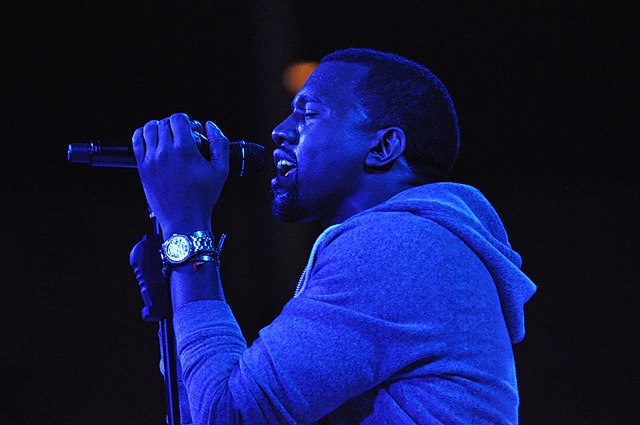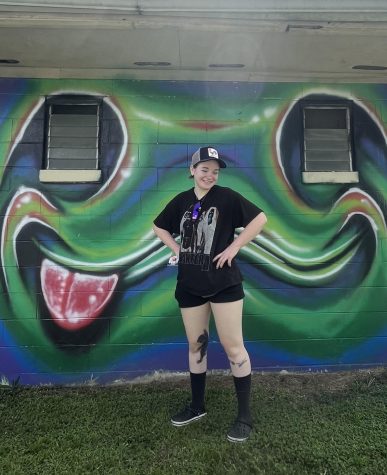Opinion | You’re saved, ‘Donda’ is not a satanic ritual
Image via Jason Persse, Wikimedia Commons
Kanye West performs at The Museum of Modern Art’s 2011 Party in the Garden benefit.
September 14, 2021
Kanye West released his debut album, “Donda,” on Aug. 29, holding a 38,000-person listening party at the Soldier Field stadium in Chicago for the album three days prior. The initial dark undertones of the piece shocked much of the live audience as well as internet bystanders.
Some even compared the performance to the likes of a satanic ritual, but I believe “Donda” and its accompanying listening party are far from it.
The listening party in Chicago featured a single, church-like house in the center of the stadium with West and his collaborators donned in intricate black attire. A crowd of what seemed like more than 100 people walked, and sometimes ran, in a circle around the sole house in the center of the stadium.
At the end of the listening party, West lights the house on fire, as well as himself, in what can only be described as typical West fashion. Rumors circulated about West’s production team handing out a red drink and selling pentagram merchandise, but these alleged incidents are insignificant when critics are evaluating the overall “satanist” undertones of “Donda.”
The album’s cover is entirely black and includes many well-known musicians such as Marilyn Manson and Kid Cudi. Generally, the songs are somewhat biblical in nature, but nothing out of the ordinary for West — who has embraced Christianity in his work over the past few years. In short, the songs on “Donda” are reasonably enjoyable and don’t obviously out themselves as satanic chants. I believe it was the outwardly abstract artistic expression of the “Donda” listening party that really upset people.
It is easy to see how West’s listening party could be confused with a satanic ritual because of the abundance of fire, pentagrams and dark themes included within the performance. These inclusions mirror that of any movie about the underworld — and ignite the same fear.
I would argue that there is nothing inherently bad about a satanic ritual, but that would probably open up a whole separate discussion that I don’t think we are quite ready for as a society with deeply embedded Christian ideals.
West’s listening party for “Donda” wasn’t anything close to a satanic ritual, but an abstract work of performance art that popular culture sensationalized because of his status and reputation. West didn’t sacrifice any humans or animals and didn’t directly name Satan at all during the performance, something that might be characteristic of a true satanic ritual. A pentagram, while widely accepted as a satanic symbol, doesn’t immediately indicate that someone is working with Satan.
It may be all good and well to ignore reactions that try to discredit uncomfortable works of art, but it is important that we as a society analyze our subconscious Christian biases so that further controversial artistic expressions aren’t misinterpreted in the future. While this issue didn’t harm West’s career in the slightest, it is clear that this album is a dedication to his mother, not to Satan.
As I was contemplating “Donda,” I couldn’t help but think about Andres Serrano’s “Piss Christ.” This photograph of a crucifix immersed in urine sparked backlash across the world in the late ‘80s. Both “Piss Christ” and “Donda” serve as artistic examples for the world to recognize their deep-seated Christian biases and the inappropriate, unquestioned sanctity at which the crucifix is held. Furthermore, art is inherently reactionary. We can enjoy art that makes us laugh or smile, but all of a sudden if it makes us scared or uncomfortable it is invalid? These works made people upset, and made them converse, and in that they did their job.
West hasn’t come out to make an explicit statement on the meaning of “Donda,” but the symbolism of the album remains abundantly clear. First, Donda was the name of West’s late mother. It can be argued that West is one of the few currently popular celebrities who actually started from humble beginnings, only having talent to propel him through the social ranks of society.
Donda West guided Kanye West through the uncertainties of fame and fortune until she suddenly passed away from a surgical mishap in 2007. The inspiration for West’s latest album is clearly his mother, and thus it would be unreasonable for the listening party to be bright and cheerful. West’s latest performance is one of trauma, mourning and grief. To compare these raw human emotions to a satanic ritual is counterproductive.
“Donda Chant” is a particularly controversial “song” on the album, because “Donda” is repeated 58 times with no music and no beat. It comes as no surprise that West’s mother was 58 years old when she died.
Lastly, the notorious house present at West’s listening party pays tribute to the house that he grew up in in Chicago, which is unsurprisingly the city where Soldier Field stadium lies. West ignites the prop house to show a sudden, tumultuous growth from his humble beginnings into the highly influential celebrity he is today.
To discredit art because it’s uncomfortable is ignorant, simply put. There have been many controversial works of art before “Donda,” and West’s latest album certainly won’t be the last. “Donda” is a work of art and it is time that it be respected as such.
Jessica Snyder primarily writes about controversy in art and politics. Write to her at [email protected].









